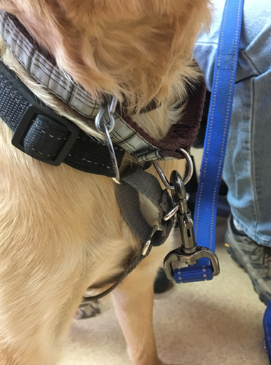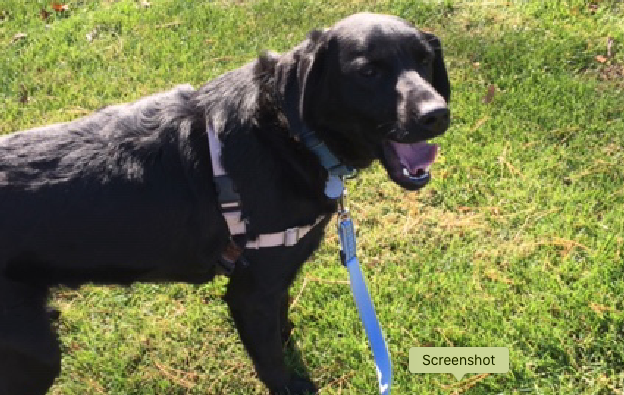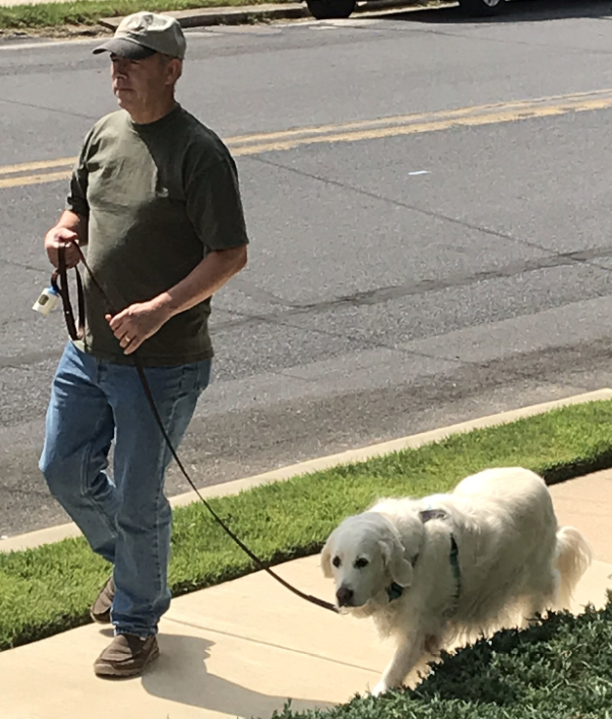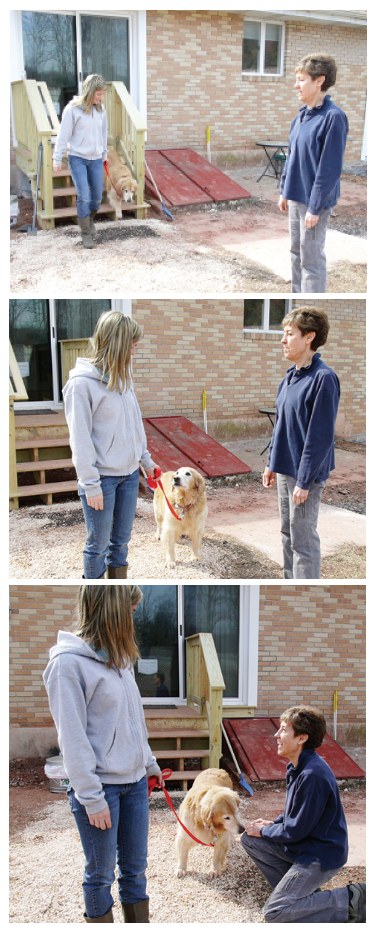 Walking on Leash and Wearing a Harness
Walking on Leash and Wearing a Harness
Walking on leash can sometimes be difficult to learn. Most of these dogs have never been on a leash before coming to DVGRR; they lived in cages, kennels, barns, or have been left to roam on a farm. Not only are they unaccustomed to wearing something around their neck, they may feel uncomfortable being held only six feet away from a human, especially if they’re very under-socialized.
We recommend a Martingale-style collar with a Pet Safe 3-in-1 Harness (or other similar harness), since many dogs can slip out of regular collars if they back up in fear. One leash should be clipped to both the front ring on the harness and the ring on the collar. Many dogs prefer being led by a harness around their body as opposed to being leashed by the sensitive neck area. You can also use the double leash method – one leash on the harness and one leash on the collar or use a slip lead. Just keep in mind that you will need to manage two leashes using that method.
Before going out for a walk, you must get them used to wearing a harness. Many puppy mill breeder dogs have trouble learning to walk on leash. Sometimes they pull while zig-zagging out of control, and other times they may flatten out like a pancake and refuse to budge. It is very easy for a dog like this to slip out of an everyday buckle or snap collar. This
is why we recommend properly fitted harnesses and martingale collars.
In addition, when a shy dog gets spooked by a noise or object on a walk or even wants to chase a squirrel, they may have a quick knee-jerk reaction to flee. For this reason, we recommend keeping the leash handle wrapped around your wrist, then held tightly in your hand for safety.
It’s important to help the dog gain comfort and confidence wearing the harness. Once you know how to properly use it, hold it out for the dog to sniff. Then slowly place the harness over their head and again, slowly attach the strap around the belly. You may try rewarding them with treats while simultaneously putting the harness over their head. Most dogs easily tolerate wearing a harness although a very few might not want to walk when one is first put on. This is why you should allow them to get used to it before you start trying to get them to walk on leash. Unlike the Easy Walk Harness, which we use to walk some of the dogs at DVGRR, the 3-in-1 can be left on the dog longer term. When properly fitted, you shouldn’t have to worry about them getting an elbow or leg stuck in it if they roll around with it on.
1. When clipping on a leash, lower yourself by squatting or sitting next to your dog, if possible. Sometimes bending over the dog is scary to them, and they may learn to associate the leash with negative emotions.
2. Gently move your dog’s collar around so the clip is in the front instead of behind their head. This way, they can see what you are doing.
3. Clip the leash on as slowly and as quietly as possible. Avoid startling your dog in any way. If they are also wearing a harness, be sure to clip the leash to the front ring of the harness and the ring on the collar.
4. Try your best not to pull or force the dog on leash and resist dragging them to get them to go where you want. Sometimes the more tension you create, the more the dog will resist. If the dog refuses to budge, try the “pull and release” method. Softly pull the leash for two seconds, then release the tension. Repeat this and see if it works for your dog. Use gentle words of praise.
5. Once your dog starts to walk, trot briskly to keep them moving. Continue praising gently and enthusiastically.
6. If they refuse to move in one direction, try walking in the opposite direction.
7. Look at the environment from your dog’s point of view and try to figure out if there is an unfamiliar obstacle or noise in the direction the dog does not want to go. If so, remove it if possible and try again or choose an alternate path.
8. Experiment with using a shorter or longer leash, depending on the behavior of your dog. Some dogs may feel safer close to you; others will need more space.
![]()
 Walking Around the Neighborhood
Walking Around the Neighborhood
You’ve made it outside and have practiced walking around the familiar backyard, but you’ve barely made it to the end of the driveway. Now what? Arm yourself with high-value treats and the adventure begins!
1. Remember that walking with another dog will often give your adopted dog confidence to venture outside of their comfort zone. Your mentor dog is usually the best choice, but a friend’s dog is also an option. Preferably, a family member or friend will walk the other dog, so you don’t have to handle both.
2. Don’t allow other people to invade the dog’s space by trying to pet or talk to them. Avoid stopping to chat with anyone else on the walk. Your goal is to get the dog accustomed to a walking routine first before introducing anything else. Explain to people that your dog is in training and needs their space. It is very important to be your dog’s advocate in this respect. Protect them and keep them safe, especially during the first few months, so it strengthens the bond between the two of you. There are special collars and harnesses made by companies with large printed words such as “DOG IN TRAINING,” “DO NOT PET,” or “SHY DOG” that you can find online to purchase.
3. Start with very limited, short walks in low-traffic/low-noise areas and use those high-value treats generously as you walk. You want your dog to start associating the high-value treats with outdoor excursions. Your dog may feel more comfortable walking along a barrier such as a fence line or wall instead of a wide-open space that can be scary. Walking your dog with another dog that is a good leash walker or even sandwiched between two dogs is a great way to teach your dog how to walk on leash and build their confidence.
4. When your dog is ready, gradually add a little more distance to your walk, perhaps an additional block. When you feel they’re ready for an area with a little more noise or traffic, feed them treats as you are approaching that area before they can hear the noise. Then walk normally and stay calm and confident. Walk straight ahead with your eye on the goal and keep moving forward. If possible, limit this to one block, then head back to a quieter area. Eventually you can add a second block and then a third as the dog gets accustomed to the noise.
5. As with other activities, go slowly. There is no need to rush the process! It may be weeks before you can attempt that longer distance or busier area. That’s okay. All dogs progress at their own pace!
6. What happens if you get out on a walk and the dog suddenly refuses to budge? Try walking in the opposite direction. Don’t be afraid to give the dog a slight pull to get them started again. Crouching down will sometimes get the dog comfortable to come closer to you – so walking the length of the leash and crouching down until the dog is walking again. Definitely take a cell phone along and have someone you can call for help. If the dog absolutely will not move, call someone to bring a car to load the dog into or even a kid’s wagon or beach wagon. The main thing is to not venture too far from home if you think this may be a possibility to happen with your dog.
![]()
 Meeting New People
Meeting New People
You will no doubt find that even when your dog has started to show increased comfort and trust with you and other immediate family members, the presence of an unfamiliar person may cause anxiety and fear. Here are some tips to use for dogs that are very fearful of people when introducing your dog to them. Having them play Treat Retreat is a good way to introduce them. (See the Treat Retreat section earlier in “Continuing the Journey.”)
Meeting People Outdoors
1. To begin, avoid having the new person approach your dog, look at your dog, try to pet your dog, give your dog treats, or otherwise engage your dog in any way. This may be hard for people who are dog lovers and want to make friends! You’ve heard it from strangers before, “All dogs love me!” You will need to be your dog’s advocate and insist that the process go super slowly, following the steps below.
2. With your dog on leash, walk them past the new person from a good distance away (approximately 20 feet) several times, decreasing the distance a bit each time only if the dog shows no negative reaction.
3. Each time your dog looks at the new person, reward them with a high-value treat.
4. Continue decreasing the distance between the dog and the new person, rewarding for calm behavior, until your dog can remain comfortable when in close range with the person. Please note – This may likely not all happen during the first session; it will take several sessions to reach this point.
5. Only allow the dog to approach the new person if they are comfortable and willing. Continue to feed high-value treats as your dog approaches.
6. It will be helpful to have the new person sit down on a bench or even kneel on the ground, so the person is at the dog’s level – this is less intimidating than standing.
7. When your dog finally approaches the new person, the person should simply allow your dog to sniff them and proceed as the dog chooses. The person should not attempt to reach out and pet your dog during the first approach. Sometimes reaching out to pet will cause the fearful dog to back up and not want to approach again. After your dog approaches several times, then the new person can start petting their chest with a low hand (they should not reach over your dog’s head).
8. Keep sessions short and always end on a positive note! This is the process that should be followed each time a new person is introduced toward whom your dog shows fear. Eventually, the dog’s behavior will change from an emotional response (fear) to a positive response (at ease).
Meeting People Indoors
Sometimes, your dog may bark at strangers entering your home out of a response to their fear of unfamiliar people, so it is important to teach your dog immediately that new people aren’t so bad. Try the following process when you are expecting guests.
1. While your guests are still in the driveway or path to your home (not at the front door), bring your dog outside on a leash. Have your dog sniff the guests and everyone walks into the house together.
2. If your dog is not yet comfortable with a leash, have the guest simply come in and sit down and not acknowledge the dog until the dog is ready. Remember (as we mentioned before) to keep your dog secured when guests enter your home, so they will not bolt out the door to an unfenced area (i.e., behind a baby gate or in a crate)!
3. Have the people ignore your dog, so the dog can sniff them. You and your guests may acknowledge your dog with a “good dog!” You can reward them with a high-value treat. Having your guest sit down will be much more comfortable for your dog since standing people can appear intimidating and scary! If your dog does not settle down or is still at a high level of fear and anxiety or if your guests are not able to keep from trying to pet your dog, it may be best to gate the dog in a quiet room or crate until your guests leave.
4. If your dog settles down, you can quietly ignore them and reward periodically with high-value treats. If your dog is responding well, you could even try to have your guest feed a high-value treat.
5. Your dog’s mentor dog will be a great teacher in situations like this. Shy dogs are much more confident to approach people when they see other trusted dogs doing so in a relaxed manner.
6. Another way you can let your dog get to know strangers is to have the person quietly and slowly move from the chair they are sitting in to the other end of the room. Then allow the dog to get a good sniff of the chair the person just vacated.
 Shy Dogs and Men (written by Cory Blair)
Shy Dogs and Men (written by Cory Blair)
It’s always a challenge working with fearful dogs, and I’ve found that as a 6’ 1” man, that challenge seems to be amplified. This is one of the lessons I’ve learned working at DVGRR. There are countless reasons why a dog might be afraid of men (maybe a man caused them some type of trauma, maybe it’s because of our size or the sound of our voice, or maybe they just aren’t a fan of facial hair), but whatever their reason, it always seems to take extra time and patience to get a fearful dog to come around to me. As a result, I often must try several different approaches and have found some approaches tend to work better for me. Since I know that the fearful behavior that dogs may display around men doesn’t go away the moment the dog is adopted, I would like to share some of my techniques for anyone who might find themselves in a similar situation.
I have had some amazing experiences working with shy dogs. The moment they finally approach you on their own for attention can be incredibly rewarding. Unfortunately, that moment is usually preceded by months of frustration trying to convince them that you are not actually scary and will not harm them. One of the most useful tools in gaining a dog’s trust is food. I’ve been most successful using high-value treats – something the dog can’t possibly resist. Most often this can be cheese, hot dogs, or even meatballs. When I start working with a dog, I’ll begin by tossing them treats whenever I walk past. If it’s in a kennel, I’ll toss a treat into the kennel, say something in a reassuring tone, and then walk away.
Eventually, shy dogs become comfortable enough around me to start taking treats from my hand. Treats are how I won over one of our very shy dogs, Ringo. When I first met Ringo, he wanted nothing to do with me. He would run away from me when we were out in the yard. When I was in his room with him, he would stay in his kennel and would not come out until I left. He felt safest in his kennel, so I started working with him by sitting alongside his kennel and tossing him bits of hot dog. Eventually, he became comfortable enough to take treats from my hand through a hole in the kennel. I then started throwing treats outside the kennel, and he would come out to take the treat and then run back in. I made sure to reward him when he got back into his kennel. It is this treat retreat method that I have found to work very well. The more we did this, the more comfortable he became with me. He started jumping up on my back when I would enter the room. When we were outside, he would come up to me to take treats. Eventually he started coming out of his kennel for scratches and pets. I had worked with Ringo for months before we got to a place where he trusted me enough to let me pet him.
Unfortunately, not all dogs are as food motivated as Ringo. For those dogs, going for walks can be a great way to bond with them and help build trust. I’ve spent almost a whole year working with one of the dogs at our Lynne Glennon Sanctuary for Senior Goldens and Puppy Mill Survivors, sitting in the room with him, feeding him treats, talking to him. We had barely made any progress until I started taking him on walks. Once we added that to our daily routine, he quickly began approaching me any time I would enter the room. Now we are at the point at which if I sit in the room with him, he sits next to me, wanting my attention.
Mentor dogs are also a great resource for helping shy dogs come out of their shell; however, I know it isn’t always possible to have multiple dogs in a home. In those cases, you can try using another human with whom the dog is already comfortable. If there is a dog that is shy around me but comfortable around my coworkers, I will try to take advantage of the opportunities when they are around. If a dog is too scared to even come out of its kennel, I can try to get someone who the dog is familiar with to bring them out to an area where I can then interact with them. If they won’t take treats from me or let me pet them, they usually do better when someone they trust is present. Some of the dogs are also afraid when people wear hats, sunglasses, or oversized jackets. I try to minimize their discomfort by removing these items when working with them. (Once the shy dog adjusts and is comfortable with you, you can slowly begin wearing these items again.)
These are only a few of the methods I use when working with fearful dogs and they may seem pretty obvious. All of the techniques I use I learned from the people I work with, so it’s not like I’m doing anything new. The main difference for me is that because of my physical appearance or the fact that I am a man, I have to understand that it may take much longer than it would take others to get a shy dog to trust me. Working with these dogs requires patience and time. The process can be frustrating, and it is easy to get discouraged, but stick with it. I find it easy to care about all of the dogs that come through the doors at DVGRR, but there is something special about the shy dogs. When they finally start to trust you, it is one of the most rewarding experiences ever… and it is those dogs that I find hardest to see go when they are adopted.

